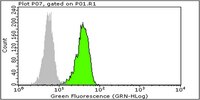Development, characterization and use of monoclonal antibodies against sTRAIL: measurement of sTRAIL by ELISA.
Liabakk, Nina Beate, et al.
J. Immunol. Methods, 259: 119-28 (2002)
2002
Kivonat megmutatása
Two monoclonal antibodies against tumor necrosis factor (TNF)-related apoptosis inducing ligand (TRAIL), designated VI10E and III6F, have been generated. These antibodies were useful in flow cytometry analysis, immunohistochemistry, immunoprecipitation and in the development of an immunoassay for the detection of soluble TRAIL (sTRAIL)in biological samples. The immunoassay was based on two monoclonal antibodies against TRAIL. VI10E was used as the capture antibody and bound TRAIL was detected with anti-TRAIL from R&D Systems which was digoxigenin (DIG)-labeled. This enzyme-linked immunosorbent assay (ELISA) was specific for TRAIL since a panel of other cytokines did not affect the signal. The immunoassay was suitable for the detection of sTRAIL in human serum and plasma samples, cell culture supernatants and cell lysates. In a preliminary screening, it was found that serum samples from human immunodeficiency virus (HIV)-infected patients contained sTRAIL, and all these positive samples were found in the AIDS group. Using the immunoassay, it was found that phytohaemagglutinin (PHA)-stimulated peripheral blood mononuclear cells (PBMC) to produce significant amounts of sTRAIL, the levels of which increased with exposure time. Thus, the immunoassay for TRAIL presented here represents a useful tool for measuring sTRAIL in various biological samples. It will also permit studies of release mechanisms as well as possible functions of the soluble form of this molecule. | 11730847
 |








